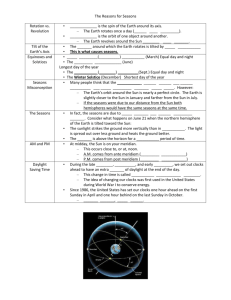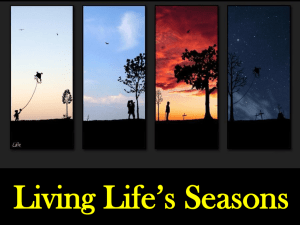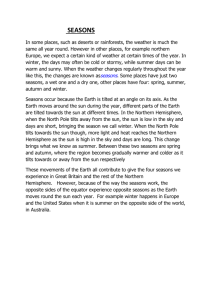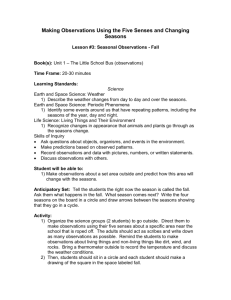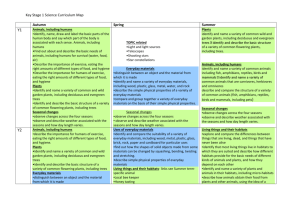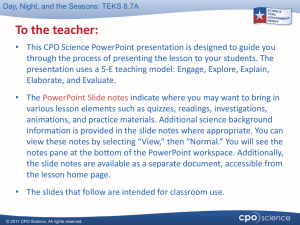Topic KS1 2 year programme - Cawthorne`s Endowed Abbeystead
advertisement
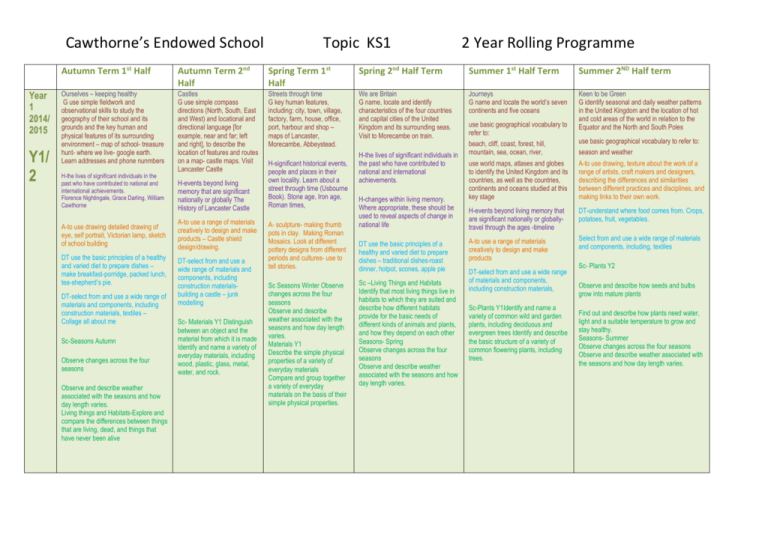
Cawthorne’s Endowed School Year 1 2014/ 2015 Y1/ 2 Topic KS1 2 Year Rolling Programme Autumn Term 1st Half Autumn Term 2nd Half Spring Term 1st Half Spring 2nd Half Term Summer 1st Half Term Summer 2ND Half term Ourselves – keeping healthy G use simple fieldwork and observational skills to study the geography of their school and its grounds and the key human and physical features of its surrounding environment – map of school- treasure hunt- where we live- google earth. Learn addresses and phone nunmbers Castles G use simple compass directions (North, South, East and West) and locational and directional language [for example, near and far; left and right], to describe the location of features and routes on a map- castle maps. Visit Lancaster Castle Streets through time G key human features, including: city, town, village, factory, farm, house, office, port, harbour and shop – maps of Lancaster, Morecambe, Abbeystead. We are Britain G name, locate and identify characteristics of the four countries and capital cities of the United Kingdom and its surrounding seas. Visit to Morecambe on train. Journeys G name and locate the world’s seven continents and five oceans Keen to be Green G identify seasonal and daily weather patterns in the United Kingdom and the location of hot and cold areas of the world in relation to the Equator and the North and South Poles H-the lives of significant individuals in the past who have contributed to national and international achievements. Florence Nightingale, Grace Darling, William Cawthorne A-to use drawing detailed drawing of eye, self portrait, Victorian lamp, sketch of school building DT use the basic principles of a healthy and varied diet to prepare dishes – make breakfast-porridge, packed lunch, tea-shepherd’s pie. DT-select from and use a wide range of materials and components, including construction materials, textiles – Collage all about me Sc-Seasons Autumn Observe changes across the four seasons Observe and describe weather associated with the seasons and how day length varies. Living things and Habitats-Explore and compare the differences between things that are living, dead, and things that have never been alive H-events beyond living memory that are significant nationally or globally The History of Lancaster Castle A-to use a range of materials creatively to design and make products – Castle shield design/drawing. DT-select from and use a wide range of materials and components, including construction materialsbuilding a castle – junk modelling Sc- Materials Y1 Distinguish between an object and the material from which it is made Identify and name a variety of everyday materials, including wood, plastic, glass, metal, water, and rock. H-significant historical events, people and places in their own locality. Learn about a street through time (Usbourne Book). Stone age, Iron age, Roman times, A- sculpture- making thumb pots in clay. Making Roman Mosaics. Look at different pottery designs from different periods and cultures- use to tell stories. Sc Seasons Winter Observe changes across the four seasons Observe and describe weather associated with the seasons and how day length varies. Materials Y1 Describe the simple physical properties of a variety of everyday materials Compare and group together a variety of everyday materials on the basis of their simple physical properties. H-the lives of significant individuals in the past who have contributed to national and international achievements. H-changes within living memory. Where appropriate, these should be used to reveal aspects of change in national life DT use the basic principles of a healthy and varied diet to prepare dishes – traditional dishes-roast dinner, hotpot, scones, apple pie Sc –Living Things and Habitats Identify that most living things live in habitats to which they are suited and describe how different habitats provide for the basic needs of different kinds of animals and plants, and how they depend on each other Seasons- Spring Observe changes across the four seasons Observe and describe weather associated with the seasons and how day length varies. use basic geographical vocabulary to refer to: beach, cliff, coast, forest, hill, mountain, sea, ocean, river, use basic geographical vocabulary to refer to: use world maps, atlases and globes to identify the United Kingdom and its countries, as well as the countries, continents and oceans studied at this key stage A-to use drawing, texture about the work of a range of artists, craft makers and designers, describing the differences and similarities between different practices and disciplines, and making links to their own work. H-events beyond living memory that are significant nationally or globallytravel through the ages -timeline DT-understand where food comes from. Crops, potatoes, fruit, vegetables. A-to use a range of materials creatively to design and make products Select from and use a wide range of materials and components, including, textiles DT-select from and use a wide range of materials and components, including construction materials, Sc-Plants Y1Identify and name a variety of common wild and garden plants, including deciduous and evergreen trees Identify and describe the basic structure of a variety of common flowering plants, including trees. season and weather Sc- Plants Y2 Observe and describe how seeds and bulbs grow into mature plants Find out and describe how plants need water, light and a suitable temperature to grow and stay healthy. Seasons- Summer Observe changes across the four seasons Observe and describe weather associated with the seasons and how day length varies. Cawthorne’s Endowed School Year 2 2015/ 2016 Y1/ 2 Families and Neighbours G name, locate and identify characteristics of the four countries and capital cities of the United Kingdom and its surrounding seas. H- changes within living memory. Where appropriate, these should be used to reveal aspects of change in national life A-line drawing DT-select from and use a wide range of materials and components, including construction materials, textiles – making teddies SC-Seasons Autumn Observe changes across the four seasons Observe and describe weather associated with the seasons and how day length varies. Living things and Habitats Identify and name a variety of plants and animals in their habitats, including micro-habitats Topic KS1 Fire G -use world maps, atlases and globes to identify the United Kingdom and its countries, as well as the countries, continents and oceans studied at this key stage Homes and Houses G use simple fieldwork and observational skills to study the geography of their school and its grounds and the key human and physical features of its surrounding environment. H-events beyond living memory that are significant nationally or globally H- changes within living memory. Where appropriate, these should be used to reveal aspects of change in national life- houses in 1900’s, 1930’s, 1960’s, 1090’s, 2015 questionnaires and interviews. Study the lives of significant individuals in the past who have contributed to national and international achievements. Samuels Pepys, Guy Fawkes A-using colour- colour mixing primary and secondary colours- firework and bonfire pictures. DTuse the basic principles of a healthy and varied diet to prepare dishes. Bread and cake making- pudding Lane recipies Sc- Identify and compare the suitability of a variety of everyday materials, including wood, metal, plastic, glass, brick, rock, paper and cardboard for particular uses A-pattern , to use a range of materials creatively to design and make products DT-select from and use a wide range of materials and components, including construction materials, Sc- Find out how the shapes of solid objects made from some materials can be changed by squashing, bending, twisting and stretching. Seasons Winter Observe changes across the four seasons Observe and describe weather associated with the seasons and how day length varies. Food and Farming G understand geographical similarities and differences through studying the human and physical geography of a small area of the United Kingdom, and of a small area in a contrasting non-European country Use basic geographical vocabulary to refer to: soil, valley, vegetation, forest, hill H- Study significant historical events, people and places in their own locality 2 Year Rolling Programme Dinosaurs and life long ago. G name and locate the world’s seven continents and five oceans H-Study events beyond living memory that are significant nationally or globally A-sculpture DTuse the basic principles of a healthy and varied diet to prepare dishes select from and use a wide range of materials and components, including construction materials, textiles A-painting ,to use a range of materials creatively to design and make products DT-understand where food comes from. Dairy, meat. Select from and use a wide range of materials and components, including construction materials, make model farm. Sc-Describe how animals obtain their food from plants and other animals, using the idea of a simple food chain, and identify and name different sources of food. Seasons- Spring Observe changes across the four seasons Observe and describe weather associated with the seasons and how day length varies. Sc- Notice that animals, including humans, have offspring which grow into adults Find out about and describe the basic needs of animals, including humans, for survival (water, food and air) Describe the importance for humans of exercise, eating the right amounts of different types of food, and hygiene. Seasons- Summer Observe changes across the four seasons Observe and describe weather associated with the seasons and how day length varies. Space G use aerial photographs and plan perspectives to recognise landmarks and basic human and physical features; devise a simple map; and use and construct basic symbols in a key. Use google earth to look at world H-events beyond living memory that are significant nationally or globally . Neil Armstrong-the lives of significant individuals in the past who have contributed to national and international achievements. A-shape, form and space. Learn about the work of a range of artists, craft makers and designers, describing the differences and similarities between different practices and disciplines, and making links to their own work. DT-select from and use a wide range of materials and components, including construction materials, textiles and ingredients, according to their characteristics Sc- Identify and name a variety of common animals including fish, amphibians, reptiles, birds and mammals Identify and name a variety of common animals that are carnivores, herbivores and omnivores Seasons- Summer Observe changes across the four seasons Observe and describe weather associated with the seasons and how day length varies. Cawthorne’s Endowed School Topic KS1 2 Year Rolling Programme

